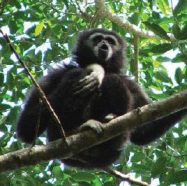G-Tunes with a Message
Apes known as gibbons can rearrange the notes of their songs to communicate with one another.
Share this:
- Share via email (Opens in new window) Email
- Click to share on Facebook (Opens in new window) Facebook
- Click to share on X (Opens in new window) X
- Click to share on Pinterest (Opens in new window) Pinterest
- Click to share on Reddit (Opens in new window) Reddit
- Share to Google Classroom (Opens in new window) Google Classroom
- Click to print (Opens in new window) Print
By Emily Sohn
Making music can be fun and relaxing. For gibbons in the forests of Southeast Asia, singing is also a way to communicate.
New research shows that these small apes vary the order of the notes in their tunes to get across certain messages. The system is simple, but it’s the first evidence that apes use something called syntax, which is an early step toward humanlike language.
 |
|
Gibbons, such as the one shown here, communicate by rearranging tunes that they sing.
|
| Esther Clarke, University of St. Andrews |
Psychologist Klaus Zuberbühler of the University of St. Andrews in Scotland and his colleagues studied 13 groups of white-handed gibbons in Thailand’s Khao Yai National Park. Between two and six gibbons lived in each group. Most groups contained a pair of adults and their offspring.
White-handed gibbons are known for their loud songs, which echo through the rainforest. Pairs of adult males and females mate for life, and these pairs perform duets, often changing the tunes over time.
To find out how gibbons react to predators, the researchers placed realistic models of predators in places where the gibbons were sure to see them. A sack wrapped in fake fur, for example, represented a leopard. And a painted, papier-mâché bird with feathers represented a crested serpent eagle.
When the gibbons saw these “predators,” they responded with songs, which the researchers recorded. Each predator-induced song began with a series of soft notes that sounded like “hoo” and included many repeats of a second note. The songs lasted about 30 minutes, and they differed from the duets that gibbons perform when no predator is present.
Other gibbons that heard the songs of their neighbors always reacted with a call of their own. They could tell the difference between duets and warnings. When the songs they heard were inspired by predator sightings, for example, the animals waited for at least 2 minutes before calling back. And they loudly repeated the same set of notes.
Syntax refers to the rules of grammar that help us arrange words into sentences. Previously, scientists believed that syntax appeared in our prehistoric ancestors only after the number of words in their vocabulary had become quite large. “We’re finding the opposite in gibbons,” Zuberbühler says.
Instead of using syntax to organize a sprawling collection of words, he says, gibbons use syntax—putting notes into different patterns—to add complexity to the small number of sounds that they can make.
This behavior is not nearly as complicated as the way humans use syntax to arrange words in different ways to convey meaning. Still, the nuances of gibbon communication have surprised scientists.







